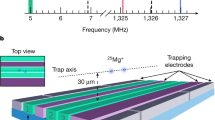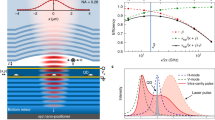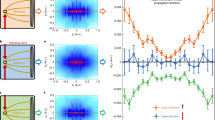Abstract
The controlled production of single photons is of fundamental and practical interest; they represent the lowest excited quantum states of the radiation field, and have applications in quantum cryptography1 and quantum information processing2. Common approaches use the fluorescence of single ions3, single molecules4,5, colour centres6,7 and semiconductor quantum dots8,9,10,11,12. However, the lack of control over such irreversible emission processes precludes the use of these sources in applications (such as quantum networks13) that require coherent exchange of quantum states between atoms and photons. The necessary control may be achieved in principle in cavity quantum electrodynamics. Although this approach has been used for the production of single photons from atoms14,15,16, such experiments are compromised by limited trapping times, fluctuating atom–field coupling and multi-atom effects. Here we demonstrate a single-photon source based on a strongly localized single ion in an optical cavity. The ion is optimally coupled to a well-defined field mode, resulting in the generation of single-photon pulses with precisely defined shape and timing. We have confirmed the suppression of two-photon events up to the limit imposed by fluctuations in the rate of detector dark counts. The stream of emitted photons is uninterrupted over the storage time of the ion, as demonstrated by a measurement of photon correlations over 90 min.
This is a preview of subscription content, access via your institution
Access options
Subscribe to this journal
Receive 51 print issues and online access
$199.00 per year
only $3.90 per issue
Buy this article
- Purchase on Springer Link
- Instant access to full article PDF
Prices may be subject to local taxes which are calculated during checkout




Similar content being viewed by others
References
Bennett, C. H. & Brassard, G. Proc. IEEE Int. Conf. on Computers, Systems, and Signal Processing (Bangalore, India) 175–179 (IEEE, New York, 1984)
Knill, E., Laflamme, R. & Milburn, G. J. A scheme for efficient quantum computation with linear optics. Nature 409, 46–52 (2001)
Diedrich, F. & Walther, H. Nonclassical radiation of a single stored ion. Phys. Rev. Lett. 58, 203–206 (1987)
Basché, T., Moerner, W. E., Orrit, M. & Talon, H. Photon antibunching in the fluorescence of a single dye molecule trapped in a solid. Phys. Rev. Lett. 69, 1516–1519 (1992)
Lounis, B. & Moerner, W. E. Single photons on demand from a single molecule at room temperature. Nature 407, 491–493 (2000)
Kurtsiefer, C., Mayer, S., Zarda, P. & Weinfurter, H. Stable solid-state source of single photons. Phys. Rev. Lett. 85, 290–293 (2000)
Brouri, R., Beveratos, A., Poizat, J.-P. & Grangier, P. Photon antibunching in the fluorescence of individual color centers in diamond. Opt. Lett. 25, 1294–1296 (2000)
Michler, P. et al. A quantum dot single-photon turnstile device. Science 290, 2282–2286 (2000)
Santori, C., Pelton, M., Solomon, G., Dale, Y. & Yamamoto, Y. Triggered single photons from a quantum dot. Phys. Rev. Lett. 86, 1502–1505 (2001)
Moreau, E. et al. Single-mode solid-state single photon source based on isolated quantum dots in pillar microcavities. Appl. Phys. Lett. 79, 2865–2867 (2001)
Yuan, Z. L. et al. Electrically driven single-photon source. Science 295, 102–105 (2002)
Santori, C., Fattal, D., Vučković, J., Solomon, G. S. & Yamamoto, Y. Indistinguishable photons from a single-photon device. Nature 419, 594–597 (2002)
Cirac, J. I., Zoller, P., Kimble, H. J. & Mabuchi, H. Quantum state transfer and entanglement distribution among distant nodes in a quantum network. Phys. Rev. Lett. 78, 3221–3224 (1997)
Kuhn, A., Hennrich, M. & Rempe, G. Deterministic single-photon source for distributed quantum networking. Phys. Rev. Lett. 89, 67901 (2002)
McKeever, J. et al. Deterministic generation of single photons from one atom trapped in a cavity. Science 303, 1992–1994 (2004)
Brattke, S., Varcoe, B. T. H. & Walther, H. Generation of photon number states on demand via cavity quantum electrodynamics. Phys. Rev. Lett. 86, 3534–3537 (2001)
Law, C. K. & Kimble, H. J. Deterministic generation of a bit-stream of single-photon pulses. J. Mod. Opt. 44, 2067–2074 (1997)
Duan, L.-M., Kuzmich, A. & Kimble, H. J. Cavity QED and quantum-information processing with “hot” trapped atoms. Phys. Rev. A. 67, 032305 (2003)
Pellizzari, T., Gardiner, S. A., Cirac, J. I. & Zoller, P. Decoherence, continuous observation, and quantum computing—a cavity QED model. Phys. Rev. Lett. 75, 3788–3791 (1995)
Beige, A., Braun, D., Tregenna, B. & Knight, P. L. Quantum computing using dissipation to remain in a decoherence-free subspace. Phys. Rev. Lett. 85, 1762–1765 (2000)
Zheng, S. B. & Guo, G. C. Efficient scheme for two-atom entanglement and quantum information processing in cavity QED. Phys. Rev. Lett. 85, 2392–2395 (2000)
Guthöhrlein, G. R., Keller, M., Hayasaka, K., Lange, W. & Walther, H. A single ion as a nanoscopic probe of an optical field. Nature 414, 49–51 (2001)
Keller, M., Lange, B., Hayasaka, K., Lange, W. & Walther, H. Deterministic coupling of single ions to an optical cavity. Appl. Phys. B 76, 125–128 (2003)
Keller, M., Lange, B., Hayasaka, K., Lange, W. & Walther, H. A calcium ion in a cavity as a controlled single-photon source. New J. Phys. 6, 95 (2004); available at http://www.iop.org/EJ/abstract/1367-2630/6/1/095
Brendel, J., Tittel, W., Zbinden, H. & Gisin, N. Pulsed energy-time entangled twin-photon source for quantum communication. Phys. Rev. Lett. 82, 2594–2597 (1999)
Acknowledgements
We gratefully acknowledge the financial support of the European Commission through the QUEST, QUBITS and QGATES networks.
Author information
Authors and Affiliations
Corresponding author
Ethics declarations
Competing interests
The authors declare that they have no competing financial interests.
Supplementary information
Supplementary Figure
Cross-correlations between four sets of measured raw data, which were used in determining the two-photon correlation function shown in Figure 3. Legend included. (PDF 79 kb)
Rights and permissions
About this article
Cite this article
Keller, M., Lange, B., Hayasaka, K. et al. Continuous generation of single photons with controlled waveform in an ion-trap cavity system. Nature 431, 1075–1078 (2004). https://doi.org/10.1038/nature02961
Received:
Accepted:
Issue Date:
DOI: https://doi.org/10.1038/nature02961
This article is cited by
-
Many-body cavity quantum electrodynamics with driven inhomogeneous emitters
Nature (2023)
-
Deterministic freely propagating photonic qubits with negative Wigner functions
Nature Photonics (2023)
-
Recent advances in room temperature single-photon emitters
Quantum Information Processing (2023)
-
Mathematical Models of Photons
Foundations of Physics (2023)
-
Single-photon source with sub-MHz linewidth for cesium-based quantum information processing
Frontiers of Physics (2023)
Comments
By submitting a comment you agree to abide by our Terms and Community Guidelines. If you find something abusive or that does not comply with our terms or guidelines please flag it as inappropriate.



